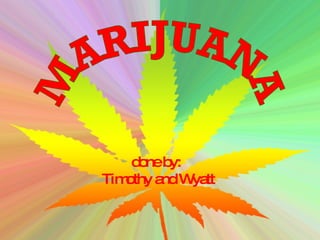Weed!! Tim Nic
- 1. MARIJUANA done by: Timothy and Wyatt
- 2. Names of Cannabis Aunt Mary, Boom, Chronic (Marijuana alone or with crack), Dope, Gangster, Ganja, Grass, Hash, Herb, Kif, Mary Jane, Pot, Reefer, Sinsemilla, Skunk, Weed.
- 3. Pictures of raw Cannabis
- 4. Effects of Marijuana The THC* in marijuana passes through the body to cannabinoid receptors in the brain causing its main effects on the body. The THC rapidly passes through the body making its effects take place quickly. *THC-main acting chemical in weed.
- 5. EFFECTS CONT. The effects of marijuana vary from person to person. Some of the main effects are: distorted perceptions impaired coordination difficulty in thinking and problem solving problems with learning and memory
- 6. Medical Purposes Marijuana has some medical use and is legal in two states in the U.S. Some medical uses are: Pain reliever Reduces ‘Tics’ for Tourettes Syndrome Scientists suggest might be therapy for seizures. There are many other medical uses for marijuana that are being discovered as research is done.
- 7. Reasons not to abuse Marijuana Weed is almost always described as a ‘Gateway’ drug. This means that marijuana users may be pushed or more likely to use other drugs. Mary J might not be addictive, but other drugs are. Such as cocaine, heroin, and opium. Abusing this drug is illegal in all 50 states.
- 8. Throughout the years, there have been many campaigns and posters advertising against using marijuana. This poster was launched in the 1930’s.
- 9. Marijuana is the most commonly used illicit drug.
- 10. Sources www.nida.nih.gov www.medicalmarijuana.procon.org www.RightHealth.com









